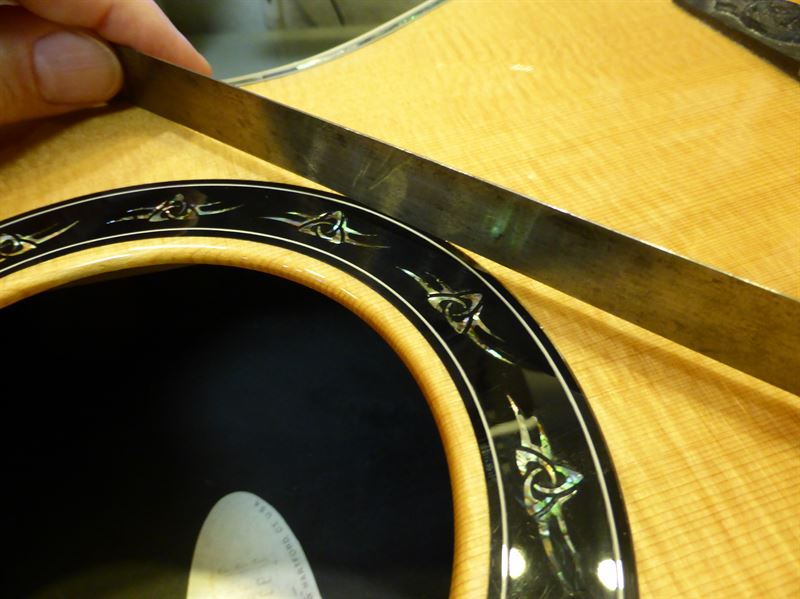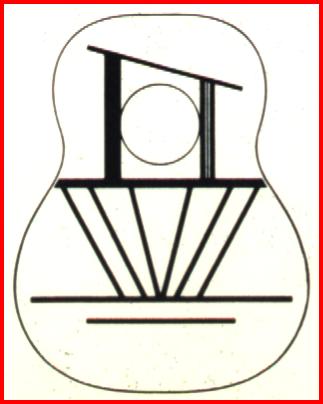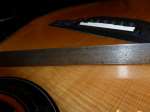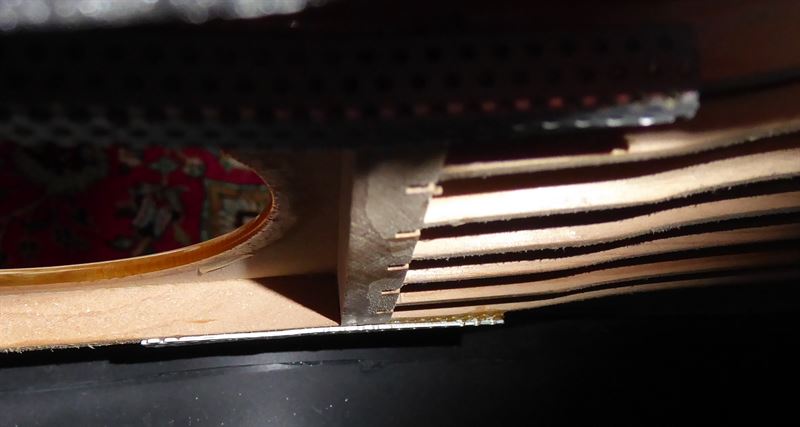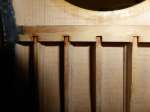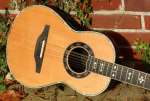|
| ||
| The Ovation Fan Club | ||
| ||
| Random quote: "Got time to breathe, got time for music." --Briscoe Darling. |
 Parlor 12 string with problems Parlor 12 string with problems
| View previous thread :: View next thread | |
| Member Communities -> Bottom Feeding Luthiery Guild | Message format | |
| DetlefMichel |
| ||
Joined: May 2011 Posts: 760 Location: Muenster/Germany | I finally got the wonderful 12 string parlor Ovation, but it shows some problems. The top has sunk between soundhole and bridge so much that even the metal pieces on the braces worked loose on both sides.I´m afraid that the whole construction will break one day. This guitar was definetely not built for the tension of 12 strings. Any good ideas? I´m trying to do the same what I did with an old 1619 before, bring pressure on the top from inside and use heat and patience... And I´ve been telling all of you for years that a 12 string guitar should NOT be played with concert pitch... | ||
| |||
| DanSavage |
| ||
Joined: June 2012 Posts: 2339 Location: Pueblo West, CO | DetlefMichel - 2017-10-23 9:57 AM I finally got the wonderful 12 string parlor Ovation, but it shows some problems. The top has sunk between soundhole and bridge so much that even the metal pieces on the braces worked loose on both sides.I´m afraid that the whole construction will break one day. This guitar was definetely not built for the tension of 12 strings. Any good ideas? I´m trying to do the same what I did with an old 1619 before, bring pressure on the top from inside and use heat and patience... And I´ve been telling all of you for years that a 12 string guitar should NOT be played with concert pitch... This is too bad. I'm sure you're very disappointed. I know I sure would be. First, I agree with you. 12-strings should not be tuned to concert pitch. I owned a Yamaha FG-260 12-string and it was always tuned a step-down. When I got my 1655 12-string a few years ago, I tried tuning it to concert pitch, but noticed that after a few weeks the top started to sink and the area below the bridge started to bulge. I immediately de-tuned and the sinking/bulging returned to normal. So, back to this sad guitar. I'm posting a photo of the A-brace to help with my discussion. (Long read) The A-brace is constructed with upper and lower sections. The upper section is made from two 5/16" wide pieces which run from the neck to the tail. The lower section is constructed from seven 1/8" wide pieces. The upper and lower braces are separated by a transverse brace that is glued just below the sound hole. The upper braces are simply butt-glued to the transverse brace. The transverse brace is notched so the lower braces form a lap joint. The glue joint betwee the two upper braces and the outer lower braces are reinforced with an perforated aluminum 90-degree strip. The perforations are meant to add gluing area, also known as 'tooth' to give the joint more strength. They also probably speed up construction as the underside of the strips don't need to be sanded as would be needed if they weren't perforated. It's these perforations that will complicate this repair. What's most likely happened is that the high string tension caused excess force to be applied to the glue joints between the upper braces and the transverse brace. Since these are simple butt joints, they could not hold up under the tension and the stress was transferred to the reinforcement strips. From the photo, it looks like they popped loose from the lower braces, but are still firmly attached to the upper braces and transverse brace. It looks to me like this is the major component of the sinking top. So, if you could glue and clamp the strips into their original positions, the majority of the sinking could probably be puilled back out. Here's the complicated part; it's going to be difficult to line up all those little holes so the strips will be able to slide back into place. What this means is that you'll probably have to remove the strips entirely, sand or grind the old epoxy away and re-glue the strips. So, what I would do initially is to conduct a test. Get a piece of wood that is long enough to reach from one side of the guitar to the other. Position it over the transverse brace, then using a couple of C-clamps positioned over the aluminum strips where they join the transverse brace. Then, slowly tighten the clamps to see if you can bring the strips up so they're back in their original position(s). If you can, then you might only have to loosen the clamps, apply some fresh epoxy to them and re-glue them. If you can't, then you'll have no choice but to remove them entirely, clean off the old glue, or at least just the little 'pins' left behind by the glue that oozed through the perforations, then re-glue and clamp. You'll probably also have to apply some glue to any braces that have popped loose. If you do have loose braces, you'll probably have to glue the braces at the same time the strips are clamped. Glue the loose braces first, then the strips. Use thin CA to re-glue the loose braces. So, how do you get the aluminum strips off the braces? I have used heat to soften the epoxy enough so the braces can be removed without bending them. Luckily, they're pretty stiff alloy. I'm not sure you can remove them without heat. You probably could, but they might bend. Worst case is you pry them off, bending them in the process. The good news is that you can email JB at the MS and he can mail you new ones. The tricky part of using heat to soften the epoxy is that you will need to apply the heat directly to the aluminum strips themselves. I would not try to heat up the outside of the top. I also wouldn't try using a heat gun to heat them up from the inside. Instead, you'll probably need a small model airplane trim iron, like those available from Coverite. (See: Coverite 21st Century Trim Sealing Iron) Or, you could use a small soldering iron. If you can't get the iron positioned correctly to apply heat directly to the strips, you'll have no choice but the pry them off cold. Once you've re-glued the braces and the reinforcement strips, most of the sinking top should be fixed. At that point, you could use the method you used on the 1619 to flatten the top. Edited by DanSavage 2017-10-23 3:25 PM | ||
| |||
| Samuels |
| ||
Joined: January 2014 Posts: 78 Location: Boise, Idaho | Thank you for being able to help and providing so much great information Dan, I'm just as disappointed as Detlef. I was assured from the previous owner that this sink was normal due to the string tension and it was perfectly fine and warranted no correction. I'm a player of these instruments only, not a repair man, and the depression never affected my ability to play it the few times I did, so I assumed they were telling the truth. If I had known this was such an issue it most certainly would not have made its way to him without being repaired at the factory first. | ||
| |||
| DanSavage |
| ||
Joined: June 2012 Posts: 2339 Location: Pueblo West, CO | Hi Samuel, Unlike the A-brace which uses separate upper and lower longitudinal braces, the K-5 brace pattern uses two massive longitudinal braces which run continuously. These are lap-jointed over the transverse brace and form a very strong system of support that would work very well on a 12-string. Here's a pic of the K-5 brace pattern. Edited by DanSavage 2017-10-24 8:27 AM | ||
| |||
| jay |
| ||
Joined: January 2009 Posts: 1249 Location: Texas | Doggone Dan...I have never thought to look at the bracing on the 68 GC12! I will check that out tonight...Thanks for providing pictures... | ||
| |||
| DanSavage |
| ||
Joined: June 2012 Posts: 2339 Location: Pueblo West, CO | YVW. I'd be interested in seeing what braces it's got, too.
I'm also going to check my 1655 12S. I believe it uses the Ovation VT-12. The 1988/89 catalog shows the 12-fret 12S were still using the Ovation fan braces, while the 14-fret 12S use the Ovation A-12. I'm guessing that the A-12 braces look like this:
| ||
| |||
| DetlefMichel |
| ||
Joined: May 2011 Posts: 760 Location: Muenster/Germany | Thank you Dan for your good advices. And I never had in mind to say that Sam sold me a bad guitar, not all of us can estimate what kind of wood process is normal and what not. I tried to work with pressure and heat first and I will try to remove* and reglue the metal strips to give the construction a little more stiffness. *just removed more tomorrow | ||
| |||
| Samuels |
| ||
Joined: January 2014 Posts: 78 Location: Boise, Idaho | Thank you Dan and Detlef, I know you were not trying to say anything bad about what had happened. I just have such a guilty conscience and I have been feeling horrible about it since finding out. I'm just very sorry but hopeful that it can be fixed. This whole ordeal has started to get me into learning more about the engineering aspect of my Ovations so that this kind of thing can be prevented in the future. Please keep us updated Detlef! | ||
| |||
| DanSavage |
| ||
Joined: June 2012 Posts: 2339 Location: Pueblo West, CO | Samuels - 2017-10-24 11:18 AM Thank you Dan and Detlef, I know you were not trying to say anything bad about what had happened. I just have such a guilty conscience and I have been feeling horrible about it since finding out. I'm just very sorry but hopeful that it can be fixed. This whole ordeal has started to get me into learning more about the engineering aspect of my Ovations so that this kind of thing can be prevented in the future. Please keep us updated Detlef! Hi Samuel, Like you, I would feel bad about selling a guitar with problems. Stuff like this happens. This one of the nice things about guitars. 99% of the time, these types of things can be repaired and the guitar brought back to life, so to speak. I don't see this one being any different. It's good that Detlef caught it before the guitar was permanently damaged. Dan Edited by DanSavage 2017-10-24 1:44 PM | ||
| |||
| DanSavage |
| ||
Joined: June 2012 Posts: 2339 Location: Pueblo West, CO | FWIW, I just checked my 1982 1655 12S and it definitely has the brace pattern show below. Because it's very similar to the K-5 braces, which are a variation of the A-brace, I'm going to guess that these are the A-12 braces referred to in the sales brochures around this time.
| ||
| |||
| DetlefMichel |
| ||
Joined: May 2011 Posts: 760 Location: Muenster/Germany | To remove the metal parts was easier than I thought. I tried an infrared-lamp first, but with a soldering iron it was quite easy to heat up the frames. And - it was easy because there were only tiny drops of glue (less is more?). In this case it was easy because I have the additional hole on the side of the guitar where the preamp is. (If you want to bring heat on the inner side of a top through the soundhole, you can also use an infrared-lamp and a mirror! I used this at the beginning of the heat treatment of the top.) Looked not too bad, no loose braces, no cracks, just little structural deformation... But I could not bent the top more than I did before (and it was quite a bit), so I left it in it´s actual stage. I egalized the steps between the different wood parts so that the metal would fit more precisely and glued them both back into place, leaving my "top pressure construction" inside for the drying process.But I used more epoxy (more is more). Now the epoxy must dry and I´ll have to wait how all this worked.I´m hopeful that I did not make more damage to the guitar than there was before. And all my A-braced guitars have tops with warps and waves, they can stand a lot. Thank you all for your sympathy and your help and extra special greetings to Sam, no complications!
| ||
| |||
| DanSavage |
| ||
Joined: June 2012 Posts: 2339 Location: Pueblo West, CO | Nice job, Detlef. I will usually allow epoxy to cure for 24 hours before I put any stress on the joint. Dan | ||
| |||
| arumako |
| ||
Joined: October 2012 Posts: 1091 Location: Yokohama, Japan | @Dan - read your comment about the K-5 bracing and strength to withstand 12-string tension; and so, I decided to take a risk against your better advice and tried some Adamas regular gauge 1919Es on my 1612; and OMG, not only are you right about the ability to withstand the tension, it is almost as if the 1612 went into turbo mode...as if the extra tension is giving the torreified top more resonance. Tightened the truss-rod a quarter turn, and tuned her to 432 (instead of 440) like I do for all my guitars. She's louder, clearer and the natural chorus effect of the O has really deepened. She was stellar with light gauge strings, but now I don't have the vocabulary to explain how awesome she is! Does that make sense? Man Detlef and Samuels, that's heart wrenching stuff there...but you're doing a great job Detlef; especially when you consider that you've got to work inside the sound hole! Are you using a mirror to get the pictures with such great angles? I wish you all the best in your repairs. I don't mean to speak for Dan, but this Parlor could be a candidate for a torrefied top in the future! Edited by arumako 2017-10-25 10:19 AM | ||
| |||
| DetlefMichel |
| ||
Joined: May 2011 Posts: 760 Location: Muenster/Germany | DanSavage - 2017-10-25 3:29 PM Nice job, Detlef. I will usually allow epoxy to cure for 24 hours before I put any stress on the joint. Dan Sure I will, the epoxy joints are going to get plenty of stress. But that´s one of the things I really don´t have: patience...it´s really hard to have this gem in your hand and you can´t play it. The guitar has an op-pro/studio preamp with a big side access hole, thus I could make pics from strange angles.. BTW the neck is not a narrow one, but obviously a normal 1658 neck, scale lenght is Ovation standard ca. 64,5mm. A black rosette with very delicate abalone inlays, never seen before (but I know old Ovations only). The whole guitar looks very (how to say that in english?) fancy? And hands off! this 12 string has such a wonderful top, no way to exchange it with a new (torrefied) one! >Just kidding< As I told you before, the sound of this little instrument is perfect, but let´s wait what it´s all about when I got better strings on it and a better setup, the nut was not made precise enough and the action was bit too high. 12 string guitars need finest tuning. | ||
| |||
| DanSavage |
| ||
Joined: June 2012 Posts: 2339 Location: Pueblo West, CO | arumako - 2017-10-25 8:15 AM @Dan - read your comment about the K-5 bracing and strength to withstand 12-string tension; and so, I decided to take a risk against your better advice and tried some Adamas regular gauge 1919Es on my 1612; and OMG, not only are you right about the ability to withstand the tension, it is almost as if the 1612 went into turbo mode...as if the extra tension is giving the torreified top more resonance. Tightened the truss-rod a quarter turn, and tuned her to 432 (instead of 440) like I do for all my guitars. She's louder, clearer and the natural chorus effect of the O has really deepened. She was stellar with light gauge strings, but now I don't have the vocabulary to explain how awesome she is! Does that make sense?! Hi Ken, Yes, what you write makes perfect sense. My recommendation for using nothing heavier than light strings on these torrefied-top guitars is because I don't know how much shear strength it has. If you exceed the shear strength, the bridge will pop off the top. So, I erred on the side of caution because I haven't done any experiments to see how much tension the torrefied wood can take before it lets go. So, in a way, you've become my QC tester. Dan | ||
| |||
| moody, p.i. |
| ||
Joined: March 2002 Posts: 15678 Location: SoCal | It would be interesting to try mediums on the Legend..... | ||
| |||
| arumako |
| ||
Joined: October 2012 Posts: 1091 Location: Yokohama, Japan | DetlefMichel - 2017-10-25 2:46 AM And hands off! this 12 string has such a wonderful top, no way to exchange it with a new (torrefied) one! >Just kidding< As I told you before, the sound of this little instrument is perfect, but let´s wait what it´s all about when I got better strings on it and a better setup, the nut was not made precise enough and the action was bit too high. 12 string guitars need finest tuning. I hear ya DetlefMichel! No sense wasting a perfectly good and beautiful top when you can salvage it! Looking forward to following your updates. On another note, you could add additional braces to the sides of the "A" brace transitions (the area where the metal plates are glued to the bracing). Two properly cut and shaped 100mm(L) x 3mm(W) x 5mm(H) maple or birch brace supports applied to each outer section of the A-brace after the top is flattened down will add a whole lot of structural strength. Unfortunately, it will hinder resonance a bit as well. There are always trade-offs. Here's hoping that the fix is much simpler! You certainly look to be headed in the right direction! Thanks for keeping us posted! Edited by arumako 2017-10-25 10:50 PM | ||
| |||
| DetlefMichel |
| ||
Joined: May 2011 Posts: 760 Location: Muenster/Germany | Hi Arumako, I had the same idea of additional braces:-) You always have good ideas, I remember your tricky bolt-on neck construction. I will decide about it when I tried the strings on it. Before the treatment the top had a concave bow of 4mm , now it´s 1,5mm: Not so much worse then other guitars I have. I can easily observe it if any changes will occur. I will let the guitar rest without the pressure tool until tomorrow and then string it up. | ||
| |||
| DanSavage |
| ||
Joined: June 2012 Posts: 2339 Location: Pueblo West, CO | I was looking at the pic below. It looks to me like all of the lower braces have sheared out of their sockets in the transverse brace. Edited by DanSavage 2017-10-26 8:56 AM | ||
| |||
| DetlefMichel |
| ||
Joined: May 2011 Posts: 760 Location: Muenster/Germany | The braces are all tight, but I think that the glue itself changed structure with the time. I guess that I could reverse this a bit with my heat and pressure treatment. In the gaps between the wood parts are too many hard drops of the glue so that you cannot simply bend the top without causing toomuch stress on the braces. All this would be quite easy if I would not have to work through the soundhole. The alu pieces were fixed with very small drops of epoxy and besides that they are not hard at all, I would say smooth. I could even adjust them to the uneveness of the wood parts, maybe I can make a pic later. I decided to add 2 braces on the sides of the center part of the bracings where the stability problem is. I got a piece of rock-hard 100 yr old spruce from a violin maker in the neighbourhood and made 2 braces out of it. I don´t think they will affect the tonality of the guitar. I first had in mind to built reinforcement "pickaback" braces for the center section, but because of the angle between the pieces I refused this idea. I made the add. braces straight first and tried them on the top inside and the top seemed to be very straight at this place. I make pics tomorrow. | ||
| |||
| DanSavage |
| ||
Joined: June 2012 Posts: 2339 Location: Pueblo West, CO | Understood. You're seeing it firsthand and I'm only seeing it through photos. You're better able to judge the stability of these joints. I just thought I'd bring it to your attention. I think that's a good idea to reinforce the side braces. And yes, you're right. It should not affect the tonality. The A-brace was designed to twist, which is what gives it its sound. Carry on. | ||
| |||
| Mark in Boise |
| ||
Joined: March 2005 Posts: 12759 Location: Boise, Idaho | That "pressure tool" you're using looks suspiciously like a wine cork. I've always admired Dan's tools and figured that my lack of tools (and talent) would be a good excuse to avoid guitar repairs. I didn't know I had "pressure tools" at my disposal. | ||
| |||
| seesquare |
| ||
Joined: November 2002 Posts: 3651 Location: Pacific Northwest Inland Empire | If you have a recent supply of a dozen, you will have no pressure. | ||
| |||
| DetlefMichel |
| ||
Joined: May 2011 Posts: 760 Location: Muenster/Germany | So I followed Dan´s advice and fixed the center braces with additional CA, to reach all stability that´s obtainable. After that I fixed the additional braces. BTW the "pressure tool" was nothing but a piece of old packaging material, a very strong kind of foam rubber. Today I cleaned the "construction site", took all my courage and put strings on it. I managed the whole ordeal without any damage or sratches and the additional braces are invisible if you look in the soundhole. I am not that heavy-handed, but this was quite an adventure for me. But thus it has become a little more "MY GUITAR". Can you understand that? Thank you all for your encouraging help! Thomastik Ac 211 with very low tension,at first very deep tuned. I had to built a new tapered shim (I always make them of one piece of wood) and then step by step tuned up to Eb (one halfstep down), like on all of my 12strings. During the process I heard no noises from the top, no clicks or creaks, felt quite good. I really cannot say if the additional braces have affected the sound of the guitar, because when I got it there were other strings on it. But if any changes I would say that it has a little more upper midrange( but this could be a figment of my imagination..), sounds very present, bell-like when played between the 5th and 12th fret. The guitar has a long sustain and more basses than you would expect to come from such a tiny instrument. The melody is well-balanced, no string seems louder than the others. The only difference to the big sisters is a certain lack of dynamics, sure the big guitars have more power when you really beat them. And the little one does not like pianissimo, she plays only mezzoforte or forte, that´s how the guitar leads you to how to play and what to play.Like all Ovation 12strings it is very easy to play, but not so simply to handle. I thought this would be a subtle finger-style guitar for playing on the sofa in the night, but no, this is a little beast, more power on the strings (Adamas graphite pick) makes much more fun. That´s it.
| ||
| |||
| DanSavage |
| ||
Joined: June 2012 Posts: 2339 Location: Pueblo West, CO | Phew! Now you can enjoy it. Yes, I know what you mean about a guitar becoming a little more of 'my guitar' once you've done some work on it. Good job! | ||
| |||
| Jump to page : 1 2 Now viewing page 1 [25 messages per page] |
| Search this forum Printer friendly version E-mail a link to this thread |
| This message board and website is not sponsored or affiliated with Ovation® Guitars in any way. | |
| (Delete all cookies set by this site) | |


